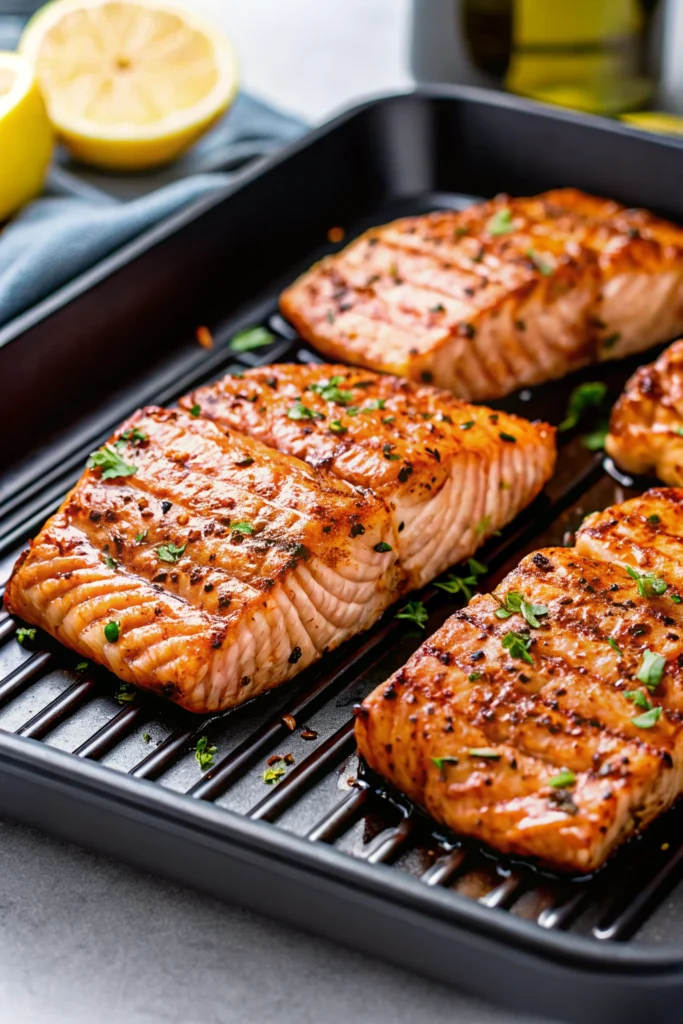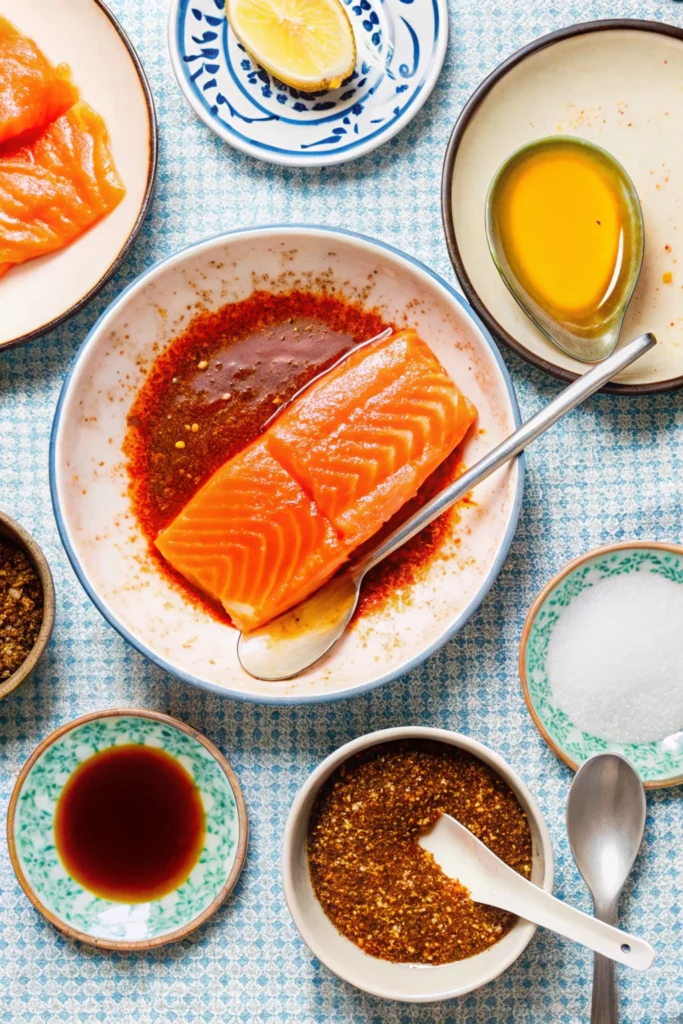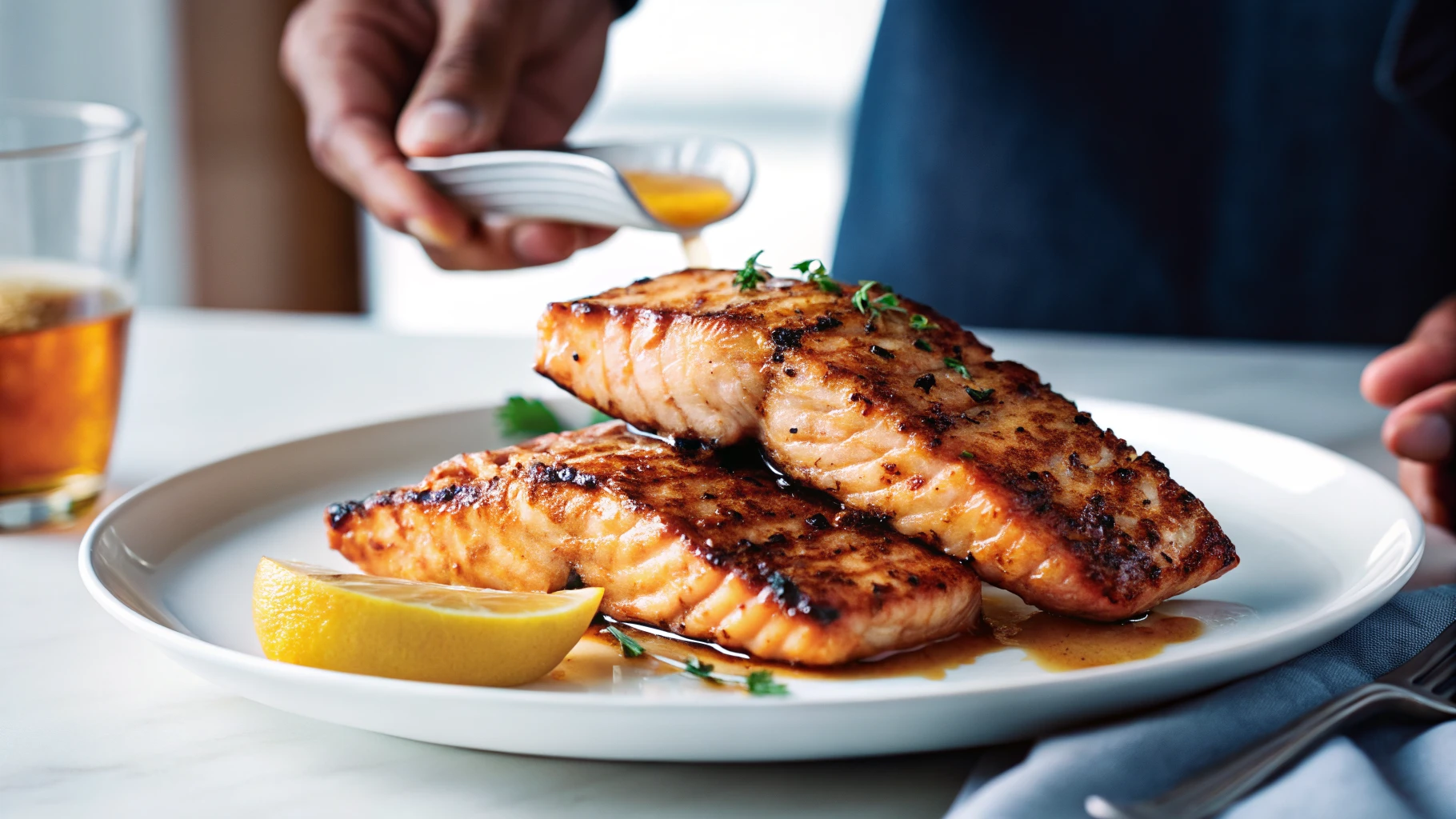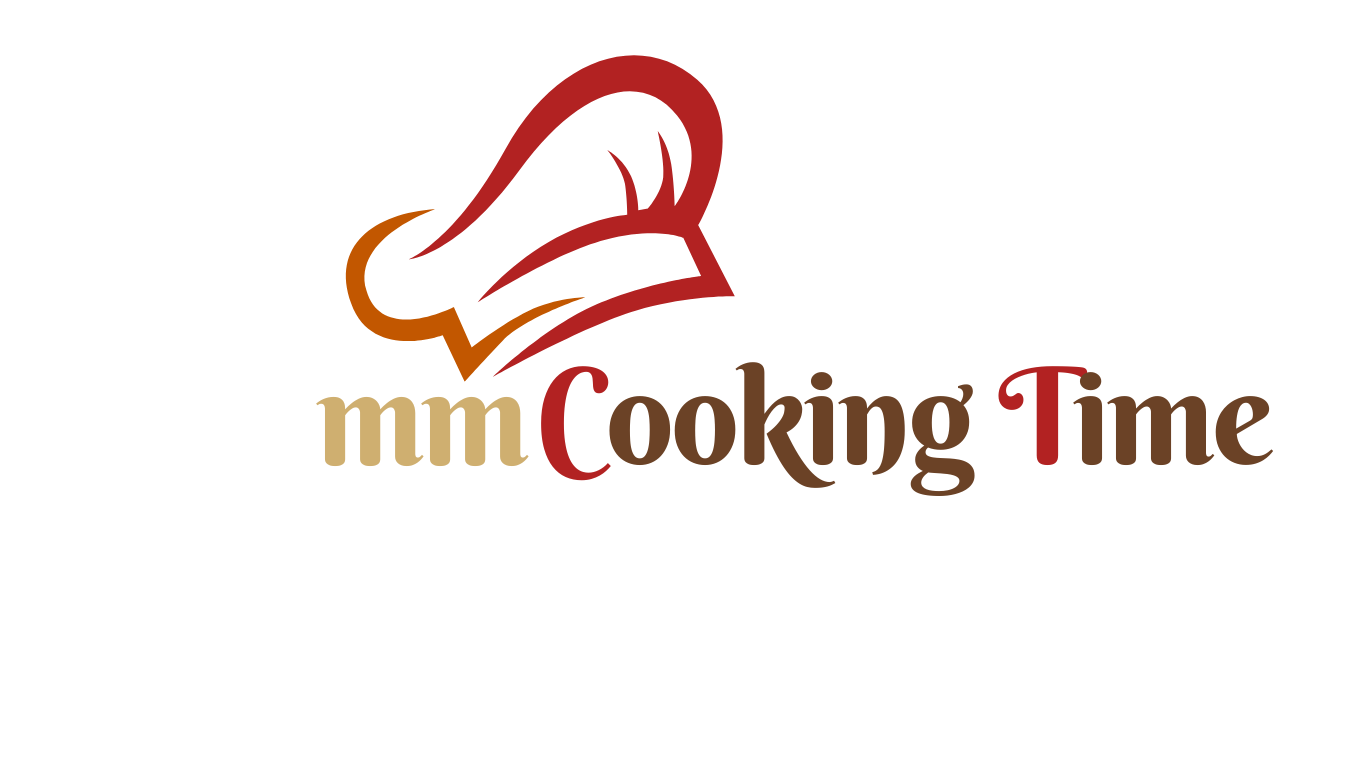The Salmon You’ll Actually Want to Cook Weekly
Let’s be honest salmon is one of those “should-cook-more” meals that often ends up on the mental backburner. Maybe you’ve had a few dry, disappointing attempts in the oven, or worse, dealt with that fishy smell that lingers for days. That’s exactly why I started air frying it.
Table of Contents
Air fryer salmon changes the whole game: no marinating, no monitoring, no fishy aftermath. Just crisp-on-the-outside, melt-in-your-mouth tender salmon with barely 10 minutes of effort. And here’s the best part you don’t need to be exact with seasonings or measurements. Just smear, sprinkle, and slide it into the basket.
Whether you’re working with frozen fillets, juggling dinner for two, or need something protein-packed for your meal prep lineup this recipe checks all the boxes. Fast. Forgiving. Flavor-forward.
In this guide, I’ll show you how to:
- Choose the best salmon (yes, frozen works!)
- Get that crispy crust without overcooking
- Customize your flavor (spicy maple glaze? Cajun crust? You bet)
- Store leftovers so they’re just as delicious the next day
Ready to ditch the guesswork? Let’s make this the weeknight salmon recipe that actually sticks.

Why Air Fryer Salmon Wins Weeknights
There’s something oddly comforting about having a go-to dinner that doesn’t involve chopping an army of vegetables or dirtying half your kitchen. For a lot of people, salmon feels intimidating. But the air fryer? It levels the playing field.
With air fryer salmon, the recipe essentially works on autopilot. Once the fish is seasoned and nestled into the basket, your job is basically done. There is no flipping, no oil splatter, and no need to hover over the stove waiting for that “just right” doneness. Just set the time and temperature and walk away.
What makes this method so effective is how evenly the hot air circulates around the fish. It crisps up the top layer into a golden crust while locking in moisture. No broiler juggling. No aluminum foil tents. Just clean, direct heat doing what it does best.
Another thing people love about air frying salmon is how well it adapts to different kitchen personalities. Whether you’re the precise type who follows every measurement or the “eyeball and go” kind of cook, this recipe will still deliver. There’s no perfect way to season your salmon. A smear of mustard here, a dusting of paprika there. It all works.
Maybe most importantly, it turns salmon from a “special effort” meal into something you can realistically cook after a long day. No fancy skills. No culinary confidence required. Just a craving for something clean, quick, and delicious.
What makes air fryer salmon better than baked?
Unlike baking, which can dry out thinner fillets or leave the top pale and soft, the air fryer delivers a crisp finish and succulent interior in a fraction of the time. It also eliminates the need to preheat a full oven, saving you time and energy in more ways than one.
Ingredients You’ll Need (And Smart Substitutions)
The beauty of this air fryer salmon recipe lies in its flexibility. You only need a handful of ingredients to create that perfect crust and juicy interior, and most of them are probably sitting in your pantry right now.
Core Ingredients
Salmon fillets
Opt for individual portions that are about six ounces each. Skin-on or skinless both work. If you’re buying fresh, look for bright color and firm flesh. If you’re using frozen, just make sure it’s fully thawed and patted dry before seasoning.
Dijon mustard
This is the flavor booster. It adds tang, helps the seasoning stick, and keeps the top layer moist. If Dijon is not your thing, you can substitute with whole grain mustard for a more textured bite or even a touch of mayo if you’re looking for creaminess over sharpness.
Paprika
This adds color and a subtle warmth. Regular paprika works fine, but smoked paprika adds a deeper layer if you want something more complex.
Garlic powder
A pantry staple that adds a savory kick. Granulated garlic also works if that is what you have on hand.
Salt and black pepper
Use kosher salt for better grip and flavor dispersion. Freshly ground black pepper adds the right punch of heat without overwhelming the other flavors.
Olive oil spray
A quick mist over the top helps lock in moisture and gives you that finished look. If you do not have spray, you can lightly brush olive oil on instead.
Ingredient Swaps You Can Trust
- No Dijon? Try Greek yogurt with a pinch of lemon zest for a creamy tang.
- Want it spicy? Add cayenne or chili powder to your paprika blend.
- No olive oil? Avocado oil works beautifully and handles high heat just as well.
- Missing garlic powder? Onion powder can step in and still bring depth.
How many fillets can you air fry at once?
Most standard air fryers can handle two fillets at a time without crowding. If you are cooking for more people, just do them in batches. It’s quick enough that no one will wait long for a plate.
Fresh vs Frozen Salmon What Really Matters
Let’s settle this once and for all. Fresh salmon sounds ideal, but is it always better? Not necessarily. The truth is, both fresh and frozen salmon can yield mouthwatering results in the air fryer. The key is understanding how to choose and handle each one.
When to Use Fresh Salmon
Fresh salmon works best when you have a trusted source. If you live near the coast or have access to a reputable fish market, you might find beautiful cuts with vibrant color and clean aroma. Fresh fillets tend to have a slightly more delicate texture and can be cooked straight from the fridge with little fuss.
However, “fresh” at the grocery store isn’t always what it seems. Many of those fillets have actually been previously frozen and thawed for display. If you’re unsure about how long it’s been sitting out, it might not be the superior choice you expect.
Why Frozen Salmon Might Surprise You
Frozen salmon often gets a bad reputation, but it shouldn’t. Most commercial suppliers flash-freeze the fish within hours of catch. This locks in moisture and nutrients at their peak. In fact, when properly thawed, frozen salmon can taste just as good as fresh and sometimes even better.
For weeknight meals or meal prep, frozen salmon is practical and consistent. You can stock up without worrying about spoilage, and the results are nearly indistinguishable when cooked well.
Pro Tips for Handling Either Option
- Always pat the salmon dry before seasoning. Moisture on the surface can prevent a good crust from forming.
- If using frozen salmon, allow it to thaw in the fridge overnight or in a bowl of cold water. Never thaw in warm water or the microwave. That ruins texture fast.
- Check for pin bones before cooking. Even frozen fillets can have sneaky ones left behind.
- Whether fresh or frozen, aim for evenly sized fillets. Consistent thickness ensures they cook evenly in the air fryer.
Which one should you choose?
It comes down to what’s available and convenient. If you find high-quality fresh salmon, great. If frozen is what fits your schedule and budget, you are not sacrificing quality. You are simply choosing flexibility.
Step-by-Step How to Make Salmon in the Air Fryer
Cooking salmon in the air fryer is one of those rare kitchen moves that feels effortless but delivers seriously impressive results. If you are used to overcooked or bland salmon, this method might completely change your mind. Here is how to get it just right, every time.
Step 1: Prep Your Fillets Properly
Start by patting each salmon fillet dry with a paper towel. This single step can make the difference between a golden, crusty top and a soggy one. Removing surface moisture helps the mustard and spices cling better and allows the heat to crisp up the outer layer.
If you see any pin bones, remove them now with tweezers or the tip of a knife.

Step 2: Add Your Flavor Base
Spread a thin, even layer of Dijon mustard over the top of each fillet. A teaspoon per piece is usually enough. You can use the back of a spoon or a silicone brush. This adds flavor, helps trap moisture, and creates a surface that grabs the spices better than dry fish alone.
Step 3: Season with Confidence
Sprinkle your salt, pepper, paprika, and garlic powder directly onto the mustard layer. You can follow measured amounts or go by eye. The goal is an even layer that covers the surface without forming clumps.
Some cooks like to mix their spices first and apply them as a blend. Others season each ingredient one at a time. Either way works. Finish with a light mist of olive oil spray to encourage even browning.

Step 4: Air Fry Like a Pro
Place your fillets skin-side down in the air fryer basket. Set the temperature to 400 degrees Fahrenheit and cook for 8 to 10 minutes. If your salmon is thicker than an inch, check it at the 10-minute mark and add a minute or two if needed.
The salmon is done when it flakes easily with a fork and has an opaque center. If you want to be extra precise, use a meat thermometer and aim for 135 to 145 degrees Fahrenheit in the thickest part.
Step 5: Rest and Serve
Once the salmon is cooked, let it rest for a couple of minutes before serving. This allows the juices to settle back into the meat and makes for a more tender bite.
Serve it right away, either as a main dish or flaked over salads, bowls, or grains. Add a squeeze of lemon to brighten things up.
What if your air fryer only fits two fillets?
That is totally fine. Just cook in batches. The second round only takes a few extra minutes and the result is just as delicious. You can keep the first batch warm in a low oven or cover loosely with foil.

Flavor Variations to Keep It Interesting
The beauty of air fryer salmon is that it starts with a simple base, but you can take it in almost any direction. Whether you lean toward sweet, spicy, smoky, or herbaceous, there is a flavor combination out there that will keep your salmon rotation feeling fresh and exciting.
Maple Dijon Glaze
For a sweet and tangy twist, mix a tablespoon of pure maple syrup with a teaspoon of Dijon mustard and a splash of apple cider vinegar. Brush it over the top of the salmon before air frying. This variation works especially well with roasted Brussels sprouts or sweet potatoes on the side.
Lemon Garlic Herb
If you prefer clean, bright flavors, this one is for you. Combine minced garlic with lemon zest, chopped parsley or dill, and a touch of olive oil. Rub it directly onto the salmon and top with a lemon slice before cooking. It gives the dish a summery freshness that pairs beautifully with grains or green vegetables.
Cajun Spice Rub
Need something with bold flavor and a little kick? Coat the salmon with olive oil and then sprinkle on a mix of paprika, garlic powder, onion powder, thyme, oregano, cayenne, salt, and black pepper. This version adds warmth and complexity, making it great for taco night or spicy rice bowls.
Soy Ginger Glaze
For an umami-rich variation, stir together soy sauce, grated ginger, minced garlic, and a touch of honey or brown sugar. Let the salmon sit in the glaze for ten minutes before air frying. This flavor combo pairs especially well with jasmine rice and steamed bok choy.
Simple Salt and Pepper with Lemon
Sometimes you want the salmon to speak for itself. A light drizzle of olive oil, a pinch of sea salt, some fresh cracked pepper, and a good squeeze of lemon after cooking can be all you need. This clean approach lets the natural richness of the fish shine through.
Can you mix and match seasonings?
Yes, absolutely. The air fryer method is forgiving, so feel free to experiment. Try garlic mustard one week, then swap in chili lime or teriyaki the next. Just avoid wet marinades that drip excessively into the fryer. Stick with glazes or rubs that cling well to the surface of the fish.
Smart Serving Ideas
Once your salmon is perfectly crisp and flaky, the question becomes what to serve with it. The good news is that this dish is a chameleon. It pairs effortlessly with bold flavors, light textures, and everything in between. You can keep it simple on a busy weeknight or build out a more complete plate when you have a little extra time.
Build a Bowl
Start with a base like brown rice, quinoa, or farro. Add in roasted or steamed vegetables such as broccoli, carrots, or green beans. Slice the salmon and lay it on top. Finish with a drizzle of tahini dressing, a spoonful of salsa verde, or a squeeze of lemon. This setup is ideal for meal prep and makes lunch the next day feel more intentional.
Pair with Seasonal Vegetables
In spring, think asparagus or sugar snap peas. In summer, lean into grilled zucchini or heirloom tomatoes with a splash of vinegar. For fall and winter, roasted root vegetables like sweet potatoes, parsnips, or squash bring out the warmth in spiced salmon. The key is to keep textures varied and flavors balanced.
Make It a Salad Topper
Flake the salmon into large chunks and add it to a bed of mixed greens. Toss in cherry tomatoes, cucumber slices, thinly shaved red onion, and a few olives for briny contrast. A mustard vinaigrette ties the flavors together while echoing the seasoning on the fish. This is a fast way to turn leftovers into something fresh and filling.
Turn It Into Tacos
Yes, really. Warm a few corn tortillas, layer in the salmon, and add shredded cabbage or slaw. Top with avocado, a dollop of sour cream, and a squeeze of lime. You can also add pickled onions or a spoonful of mango salsa if you are feeling adventurous.
Keep It Classic
Of course, there is always the classic dinner plate. Serve the salmon alongside mashed potatoes or herbed couscous and a green like sautéed spinach or roasted Brussels sprouts. Add a lemon wedge and dinner is served.
What about sauces or dips?
Salmon loves a good sauce. Try mixing Greek yogurt with lemon and dill for a quick creamy dip. Or go bold with a chimichurri, pesto, or even a drizzle of sriracha mayo. A flavorful sauce can elevate the dish without much extra effort.
How to Store and Reheat Leftover Salmon
If you happen to have extra salmon after dinner, you are in luck. Properly stored, leftover salmon can be just as satisfying the next day. The key is to preserve moisture and flavor without turning it rubbery or dry. Here is how to do it right.
Storing Leftover Salmon
Let the salmon cool completely at room temperature before storing. This helps prevent condensation from forming inside the container which can lead to soggy textures. Once it is cool, place the fillets in an airtight container and refrigerate.
For best quality, try to eat the leftovers within three days. If you do not plan to use them that quickly, freezing is a great option. Wrap each piece tightly in parchment or foil, then place it in a freezer-safe container or zip-top bag. Label with the date so you remember when you froze it.
Reheating Tips That Work
Reheating salmon is tricky because it is already cooked and delicate. The goal is to warm it without drying it out.
In the oven:
Place the salmon in a baking dish and cover it with foil. Heat it at a low temperature around 275 degrees Fahrenheit for about ten to fifteen minutes. This method gently warms the fish without stripping away moisture.
In the air fryer:
You can absolutely reheat salmon in the air fryer, but keep it on a lower setting. Try 350 degrees Fahrenheit for three to five minutes. Add a spritz of olive oil and keep a close eye on it.
In the microwave:
While not ideal, it is the fastest option. Cover the salmon with a damp paper towel to create a little steam. Microwave in short bursts of thirty seconds until warm. Be aware that the texture might change slightly.
Can you serve it cold?
Absolutely. Cold salmon can be flaked into a salad, stirred into a grain bowl, or tucked into a wrap with greens and dressing. It is a great way to repurpose leftovers without reheating at all.
FAQ Your Salmon Questions Answered
Do I need to flip salmon in the air fryer?
No flipping is necessary. The air fryer circulates heat evenly around the fillet so you can place the salmon skin-side down and let it cook through without any movement. This helps the top stay intact and the fish remain juicy.
Can I use frozen salmon straight from the freezer?
Technically yes but the results may vary. For best texture and flavor, it is recommended to thaw the salmon first. You can place it in the fridge overnight or use the cold water method by sealing it in a plastic bag and submerging it in a bowl of cold water for about thirty minutes.
How do I know when salmon is fully cooked?
The flesh should turn opaque and flake easily with a fork. If you want to be exact, use a food thermometer and check the thickest part. The USDA recommends an internal temperature of 145 degrees Fahrenheit. Some people prefer stopping at 135 and letting the carryover heat finish the job.
Can I cook multiple fillets at once?
Yes you can but spacing is key. Make sure the fillets are not touching so hot air can circulate properly. If you are cooking for a group, work in batches rather than cramming everything into the basket at once.
What is the best way to season salmon if I do not have mustard?
If you are out of mustard you can try a light coating of olive oil followed by your favorite spice mix. You can also use Greek yogurt with lemon and herbs or even a spoonful of mayo blended with garlic and paprika for a rich crust alternative.
Final Thoughts Why This Recipe Sticks
Some recipes earn a spot in your rotation because they are fast. Others because they are healthy. And some because they feel like a win every time you make them. This air fryer salmon hits all three without asking much of you in return.
It is the kind of dish that works when you are running behind and just need dinner to happen. It also works when you are trying to eat cleaner and still want real flavor. Maybe most importantly it gives you that small kitchen victory at the end of a long day when everything else felt a little out of sync.
The crust is crispy. The center stays moist. And the cleanup is almost nothing. That alone makes it worth repeating.
But what really makes it stick is how customizable it is. You can switch up the seasoning. Pair it with any side you like. Serve it hot or cold. There is no pressure to make it perfect. Just make it yours.
So whether you are cooking for yourself or feeding a family this recipe has the flexibility to show up exactly how you need it. And once you try it you may wonder why you ever bothered cooking salmon any other way.

Air Fryer Salmon
Ingredients
Method
- Pat each salmon fillet dry with a paper towel to remove surface moisture. Check and remove any pin bones.
- Spread a thin layer of Dijon mustard over the top of each fillet using the back of a spoon or a silicone brush.
- Season each fillet evenly with paprika, garlic powder, salt, and black pepper. Mist the top lightly with olive oil spray.
- Place the fillets skin-side down in the air fryer basket. Cook at 400°F (204°C) for 8–10 minutes, depending on thickness.
- Check for doneness—the salmon should flake easily and be opaque. Rest for 2 minutes before serving. Add lemon if desired.
Notes
Nutrition
Calories: 291.7kcal Carbohydrates: 0.8g Protein: 33.9g Fat: 16.1g Saturated Fat: 2.4g Polyunsaturated Fat: 4.9g Monounsaturated Fat: 7.4g Cholesterol: 93.5mg Sodium: 75.6mg Potassium: 848.4mg Fiber: 0.2g Sugar: 0.1g Vitamin A: 197.7IU Vitamin C: 0.9mg Calcium: 27.6mg Iron: 1.7mgConclusion
If there is one thing this recipe proves, it is that cooking salmon does not have to be complicated to be crave-worthy. You do not need fancy tools or culinary training. Just a few ingredients, a bit of confidence, and an air fryer.
Whether you are cooking for the first time or adding another staple to your weekly lineup, this approach lets you win at dinner without stress. You get crispy edges without babysitting a pan. You get tenderness without guessing. And you get a meal that feels nourishing without losing flavor.
So maybe tonight is not about chasing perfection. Maybe it is just about pulling off a simple meal that tastes like it took more effort than it actually did. That is the quiet power of this recipe. It fits into your life instead of disrupting it.
When you try it, make it your own. Add that extra squeeze of lemon. Try a glaze that speaks to your style. Or keep it exactly as written and enjoy how easy something good can be.
Now go ahead and make your kitchen smell amazing.
More Air Fryer Chicken Recipes You’ll Love
Air Fryer Chicken Breast
Air Fryer Chicken Wings
Disclaimer: The recipes and nutrition information on this blog are provided for general informational purposes only. They are not intended as medical advice or as a substitute for professional dietary guidance.
Always consult a qualified healthcare or nutrition professional before making significant changes to your diet, especially if you have specific health conditions or dietary needs.
